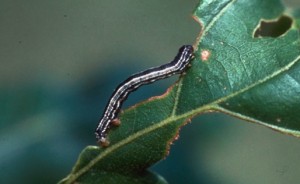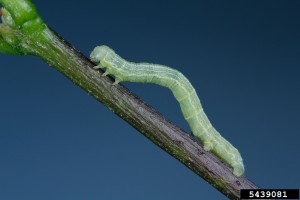Cankerworms
go.ncsu.edu/readext?434306
en Español / em Português
El inglés es el idioma de control de esta página. En la medida en que haya algún conflicto entre la traducción al inglés y la traducción, el inglés prevalece.
Al hacer clic en el enlace de traducción se activa un servicio de traducción gratuito para convertir la página al español. Al igual que con cualquier traducción por Internet, la conversión no es sensible al contexto y puede que no traduzca el texto en su significado original. NC State Extension no garantiza la exactitud del texto traducido. Por favor, tenga en cuenta que algunas aplicaciones y/o servicios pueden no funcionar como se espera cuando se traducen.
Português
Inglês é o idioma de controle desta página. Na medida que haja algum conflito entre o texto original em Inglês e a tradução, o Inglês prevalece.
Ao clicar no link de tradução, um serviço gratuito de tradução será ativado para converter a página para o Português. Como em qualquer tradução pela internet, a conversão não é sensivel ao contexto e pode não ocorrer a tradução para o significado orginal. O serviço de Extensão da Carolina do Norte (NC State Extension) não garante a exatidão do texto traduzido. Por favor, observe que algumas funções ou serviços podem não funcionar como esperado após a tradução.
English
English is the controlling language of this page. To the extent there is any conflict between the English text and the translation, English controls.
Clicking on the translation link activates a free translation service to convert the page to Spanish. As with any Internet translation, the conversion is not context-sensitive and may not translate the text to its original meaning. NC State Extension does not guarantee the accuracy of the translated text. Please note that some applications and/or services may not function as expected when translated.
Collapse ▲Cankerworms:
Paleacrita vernata (spring); Alsophila pometaria (fall)
Prepared by: Bill Smith, Union County Urban Forester/ Certified Arborist.
2013 Location of Infestation in Union County, NC: Marvin, Weddington and Indian Trail
Host plants: A wide variety of trees and plants including apple, ash, beech, birch, boxelder, cherry, dogwood, elm, hickory, linden, maple, and oak.
Trees seldom infested: tulip poplar, cottonwood, sweetgum and conifers (pine, cedar, etc.).
Description:
The caterpillar of the fall cankerworm matures at about one inch long and varies from light green to dark brownish green, with three narrow yellowish lines on each side of a wider darker middle strip along the back. Fall cankerworms have three pairs of prolegs (hind legs), with the forward pair being smaller.
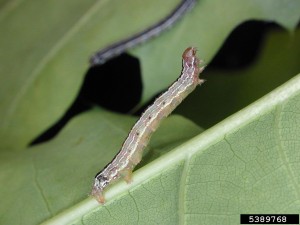 Ronald S. Kelley, Vermont Department of Forests, Parks and Recreation, Bugwood.org
Ronald S. Kelley, Vermont Department of Forests, Parks and Recreation, Bugwood.org
The caterpillar of the spring cankerworm matures at about one and one-half inches long. The body color can vary from yellowish green to reddish brown to black. Most will have a single white to yellow stripe along each side of the body. Spring cankerworms will have two pairs of prolegs (hind legs).
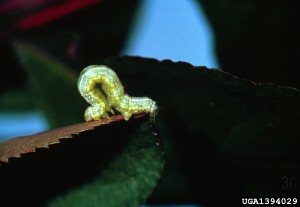
James B. Hanson, USDA Forest Service, Bugwood.org
Life Cycle:
As the young tender leaves of a tree emerge, cankerworms hatch and begin feeding, usually beginning about the last week of March. They feed through the first growth surge of budding leaves. Young caterpillars chew small holes in leaves. Mature caterpillars consume the entire leaf, leaving only the main leaf veins. High populations can completely defoliate trees. If defoliated, trees will normally follow with a second growth of leaves after the cankerworms have stopped feeding. Several years of defoliation could cause death of the tree. High populations cause a lot of mess below. Frass (small pellets of poop) raining down from the tree, and caterpillars dropping down on silk threads, cover everything below. They are not harmful to people, just unpleasant.
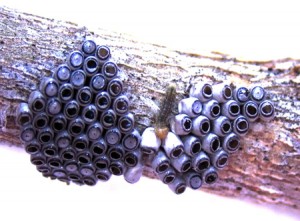 Cankerworm crawler emerging from egg cluster.
Cankerworm crawler emerging from egg cluster.
https://digitalcommons.usu.edu/extension_curall/868
Feeding will last until about the first of May. When the cankerworm caterpillar reaches maturity, it drops to the ground on silk threads, burrows from 1 to 4 inches into the soil, spins a silk cocoon and pupates; remaining in the latter state until fall (fall cankerworm,) or mid-winter (spring cankerworm.) Fall cankerworms emerge, as moths, just after our first occurrence of about three days of sub-thirty degree weather, usually just after Thanksgiving. Spring cankerworms may lay eggs up to the middle of March. The female of both species is a wingless moth and must crawl up the tree to lay eggs. The eggs are barrel-shaped and stacked in clusters. Now, we are back to late March and the process starts all over again.
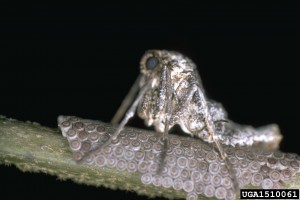 Female cankerworm moth on egg cluster.
Female cankerworm moth on egg cluster.
USDA Forest Service – Region 8 – Southern Archive, USDA Forest Service, Bugwood.org
Cankerworm control:
Insecticide Controls: Spraying biological or chemical controls should be done in the early caterpillar stage. The City of Charlotte has sprayed high infestation areas with Bacillus thuringiensis (Bt). Bt is a bacterial agent that affects caterpillars and is harmless to other insects. Chemical control by the homeowner is limited to retail chemicals licensed specifically for caterpillars. Homeowner application is physically limited by the height of the trees and delivering chemicals to those heights. Commercial applicators are able to apply commercial chemicals to a greater height.
Physical control: The most effective and environmentally safe method is trapping. The vulnerable time in the life cycle of the cankerworm is when the wingless female moth is crawling from the ground up the trunk of the tree to lay eggs. “Sticky band” traps easily capture the females as they climb the trunks. Trapped females still attract males, which also become trapped. If the traps are maintained until the first of May, caterpillars drifting down on silk webs or climbing back up the trunk will be captured.
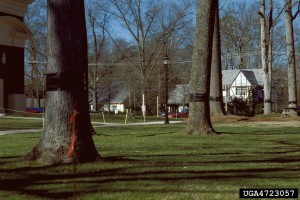 Keith Douce, University of Georgia, Bugwood.org
Keith Douce, University of Georgia, Bugwood.org
TREE BANDING:
Sticky tree bands should be put up by the end of November, or as soon as most of the leaves have fallen from the trees. Leaves and debris sticking to the trap can make it ineffective. The traps should be checked frequently with glue reapplied as needed. Trees to be banded are listed above in the Host Plants. If resources are limited, band the largest overstory trees first.
How to make the band:
- At eye level, wrap batting material around the tree and secure with staples or tape. Be sure to fill in all of the gaps left in irregular shape trees and deeply fissured bark. This keeps the moths from being able to crawl underneath the trap. Batting material can be strips of batting from a fabric store, or precut pipe insulation from a hardware store. Pipe insulation comes in three or four inch widths, and is easier to handle.
- Staple or duct tape a nine to twelve inch strip of tarpaper, or roofing felt, around the tree with the, already applied, batting at the inside top of the tarpaper strip. Allowing the batting to be barely visible from the top of the tarpaper lets you see if there are any gaps where moths can sneak through. All gaps should be filled with extra batting. An alternative to tarpaper is to wrap over the batting with a Saran Wrap type product. Plastic wrap products for storage are available at hardware stores and office product stores. The Sarantm Wrap type products are easier to use on smaller trees.
- Tanglefoottm is sticky glue that does not readily dry out. Its original application was for trapping pest (rodents, birds, etc.). Apply a three-inch band of Tanglefoottm around the lower 1/3 of the tarpaper. This will allow room above the Tanglefoottm for touch-up applications. You will need a spatula and disposable gloves for the Tanglefoottm
- Reapply, check and reapply some more. The moths become active about the first of December and remain active until March. Caterpillars will become active in April and remain active until May. If kept fresh, the sticky traps will capture both the egg laying moths and many of the caterpillars as they silk down from the tree, or try to crawl back up the tree trunk. Check traps at least once a month. The first of each month is a good target date for checking. If, in the current year, there is a small population of moths, re-application may not be necessary.
- Important! Remove the traps on the first of May. Leaving the traps up can cause damage to the bark.
Supplies:
Tree Banding Supplies can be purchased at the following retail stores:
Blackhawk Hardware, 4225 Park Road Shopping Center, 704-525-2682
Faulk Brothers, 5744 N. Tryon Street, 704-596-7474
Little Hardware Co., 1400 South Mint Street, 704-333-3133
Monroe Hardware, 6912 Matthews-Mint Hill Rd, Mint Hill, NC 28227, 704-526-2776
Norwood Garden Center, 8837 Albemarle Road, Charlotte, NC, 704-536-4848
Potts Hardware, 5201 Nations Ford Road, Charlotte, NC, 704-523-7112
Southern Ace Hardware Co., 3528 Wilkinson Blvd, Charlotte, NC 704-399-7131
The Hunter Farm,13624 Providence Rd, Weddington, NC, 704-846-7975
http://www.charmeck.org/city/charlotte/epm/Services/Landscaping/Pages/fall%20cankerworm.aspx
Literature cited
https://utahpests.usu.edu/ipm/htm/advisories/landscape/articleID=12700
http://cues.cfans.umn.edu/old/Web/086Cankerworms.pdf
http://www.fs.fed.us/foresthealth/technology/pdfs/Forest_Pest_Insects_Photo_Guide_508.pdf Page 511.
http://www.jackmcneary.com/html/cankerworms_2012-2013.htm
http://www.charmeck.org/city/charlotte/epm/Services/Landscaping/Pages/fall%20cankerworm.aspx
http://www.elizabethcommunity.com/images/EverythingYouNeedtoKNowaboutECABanding07.pdf
http://www.charmeck.org/city/charlotte/epm/Services/Landscaping/Pages/fall%20cankerworm.aspx
Download this document:





